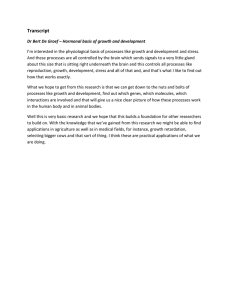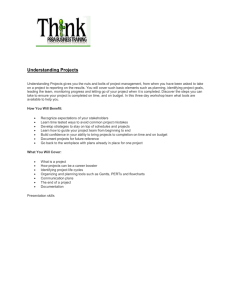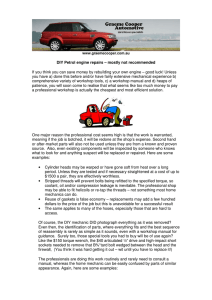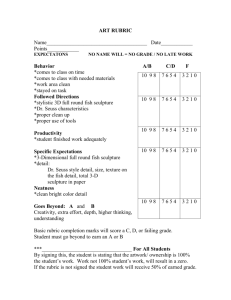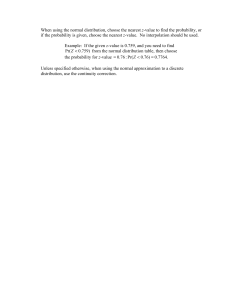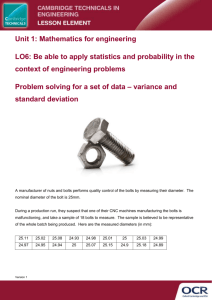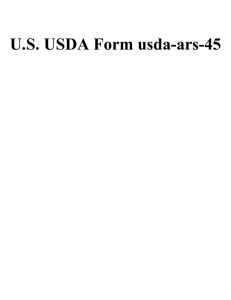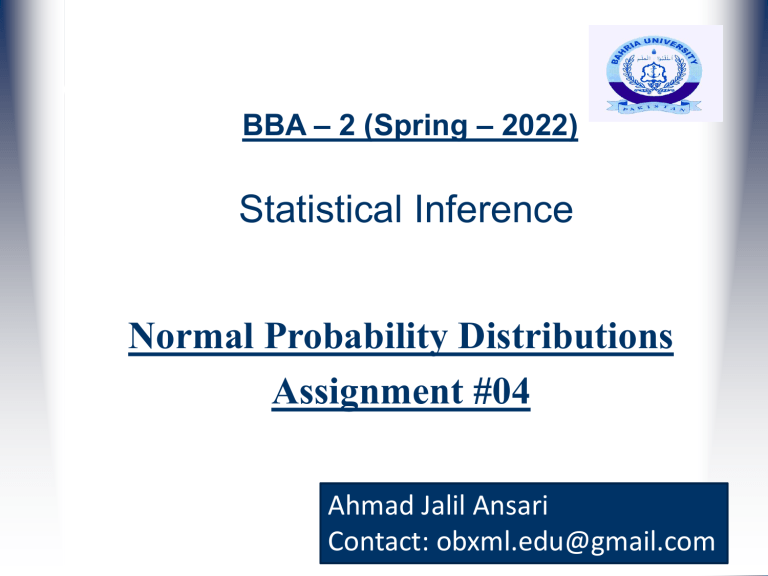
BBA – 2 (Spring – 2022) Statistical Inference Normal Probability Distributions Assignment #04 Ahmad Jalil Ansari Contact: obxml.edu@gmail.com Question: #01 If X is ~N(𝟑𝟎 , 𝟓) find a, b, c and d in following questions: i. P(a < X < 40) = 76.54% ii. P(26 < X < b) = 76.54% iii. P(X > c) = 0.135% iv. P(X < d) = 21.19% 𝜇=0 Question: #01 (i) If X is ~N(𝟑𝟎 , 𝟓) find a, b, c and d in following questions: i. P(a < X < 40) = 76.54% Part(i) ⟹ ⟹ ⟹ ⟹ ⟹ ⟹ ⟹ ⟹ 𝜇=0 P(a < X < 40) = 0.7654 z1 = (a – 30) / 5 P((a – 30) / 5 < Z < 2.0) = 0.7654 z2 = (40 - 30) / 5 = 2.0 P(Z < 2.0) - P(Z< (a – 30) / 5) = 0.7654 0.97725 - P(Z < (a – 30) / 5) = 0.7654 P(Z < (a – 30) / 5) = 0.97725 - 0.7654 P(Z < (a – 30) / 5) = 0.21186 (a – 30) / 5 = -0.8 [from Cum. Std. Norm. Dist. Table] P(-0.8) = 0.21186 a – 30 = -4.0 by searching for z-value that relates to a = 26.0 probability = 0.21186 Question: #01 (ii) If X is ~N(𝟑𝟎 , 𝟓) find a, b, c and d in following questions: ii. P(26 < X < b) = 76.54% 𝜇=0 Part(ii) P(26 < X < b) = 76.54% z1 = (26 – 30) / 5 = -0.8 ⟹ P((b – 30) / 5 < Z < 2.0) = 0.7654 z = (b - 30) / 5 ⟹ P(Z < (b - 30) / 5) - P(Z < -0.08) = 0.7654 2 ⟹ P(Z < (b - 30) / 5) – 0.21186 = 0.7654 ⟹ P(Z < (b – 30) / 5) = 0.7654 + 0.21186 ⟹ P(Z < (b – 30) / 5) = 0.97726 ⟹ (b – 30) / 5 = 2.0 [from Cum. Std. Norm. Dist. Table] P(2.0) = 0.97726 ⟹ b – 30 = 10.0 by searching for z-value that relates to ⟹ b = 40.0 probability = 0.97726 Question: #01 (iii & iv) If X is ~N(𝟑𝟎 , 𝟓) find a, b, c and d in following questions: iii. P(X > c) = 0.13.5% iv. P(X < d) = 21.19% 𝜇=0 Part(iii) z1 = (c - 30) / 5 P(X > c) = 0.00135 ⟹ P(X < c) = 1 - 0.00135 ⟹ P(Z < (c - 30) / 5) = 0.99865 ⟹ (c - 30) / 5 = 3.0 [from Cum. Std. Norm. Dist. Table] P(3.0) = 0.99865 ⟹ c = 45 by searching for z-value that relates to probability = 0.99865 Part(iv) P(X < d) = 0.2119 z1 = (d - 30) / 5 ⟹ P(X < (d - 30) / 5) = 0.2119 ⟹ (d - 30) / 5 = -0.8 [from Cum. Std. Norm. Dist. Table] ⟹ d = 26 P(-0.8) = 0.2119 by searching for z-value that relates to probability = 0.2119 Question: #02 Find the indicated quantities given that X is ~N(80 , 4). A) Find the value of b such that P(X ≤ b) = 0.9719. B) Find the value of c such that P(X ≥ c) = 0.9678. C) Find the values of A & B such that P(A ≤ X ≤ B) = 0.2961, if A and B are symmetric about mean. 𝜇=0 Question: #02 (A & B) X ~N(80 , 4). A) Find the value of b such that P(X ≤ b) = 0.9719. B) Find the value of c such that P(X ≥ c) = 0.9678. 𝜇=0 Part(A) z1 = (b - 80) / 4 P(X ≤ b) = 0.9719 ⟹ P(X < (b - 80) / 4) = 0.9719 ⟹ (b - 80) / 4 = 1.91 ⟹ b = 80 + 4(1.91) P(1.91) = 0.9719 by searching for z-value that relates to probability = 0.9719 ⟹ b = 87.64 Part(B) P(X > c) = 0.9678 z1 = (c - 80) / 4 ⟹ P(X < c) = 1 - 0.9678 ⟹ P(Z < (c - 80) / 4) = 0.0322 ⟹ (c - 80) / 4 = -0.46 ⟹ c = 80 + 4 (-0.46) P(-0.46) = 0.0322 by searching for z-value that relates to probability = 0.0322 Question: #02 (C) X ~N(80 , 4). C) Find the values of A & B such that P(A ≤ X ≤ B) = 0.2961, if A and B are symmetric about mean. 𝜇=0 . Part(C) z1 = (A - 80) / 4 and z1 = (B - 80) / 4 P(A ≤ X ≤ B) = 0.2961 ⟹ P(X < (B - 80) / 4) - P(X < (A - 80) / 4) = 0.2961 Now A and B are symmetrical to center( i.e. mean) therefore P(X < (B - 80) / 4) = 0.5 + (0.2961/2) = 0.64805 and P(X < (A - 80) / 4) = 0.5 - (0.2961/2) = 0.35195 P(X < (B - 80) / 4) = 0.64805 As P(Z < 0.38) = 0.64805 ⟹ (B - 80) / 4) = 0.38 ⟹ B = 80 + 4(0.38) ⟹ B = 81.52 P(X < (A - 80) / 4) = 0.35195 As P(Z < -0.38) = 0.35195 ⟹ (A - 80) / 4) = -0.38 ⟹ A = 80 + 4(-0.38) ⟹ A = 78.48 Question: #03 Most graduate schools of business require applicants for admission to take the GMAT exam. Scores on the GMAT are roughly normally distributed with a mean of 527 and a standard deviation of 112. i) What is the probability of an individual scoring above 500 on the GMAT? Ii) How high must an individual score on the GMAT in order to score in the highest 5%? Part(i) P(X > 500) = 1 - P(X < 500) z = (500 – 527)/112 = -0.241 = P(z < -0.241) = 0.40517 = 40.517% Part(ii) P(X > a) = 0.05 P(X < a) =0.95 ⟹ P(Z< (a – 527) / 112) = 0.95 ⟹ (a – 527) / 112 = 1.645 ⟹ a = 527 + 112 (1.645) ⟹ a = 711.24 z = (a – 527)/112 Question: #04 The average number of acres burned by forest and range fires in a large New Mexico county is 4,300 acres per year, with a standard deviation of 750 acres. The distribution of the number of acres burned is normal. i) What is the probability that between 2,500 and 4,200 acres will be burned in any given year? Ii) What number of burnt acres corresponds to the 38th percentile? X ~N(4300 , 750) Part(i) P(2500< X > 4200) = ? z1 = (2500 – 4300)/750 = -2.4 z2 = (4200 – 4300)/750 = -1.3333 P(2500< X < 4200) = P(X < 4200) – P(X < 2500) = P(Z < (--1.3333) – P(Z <-2.4) = 0.4483 -.0082 = 0.4401 = 44.01% Part(ii) P(X < a) = 0.38 (As P38 means 38% are below a) z = (a – 4300)/750 ⟹ P(Z< (a – 4300) / 750) = 0.38 ⟹ (a – 4300) / 750 = -0.31 ⟹ a = 4300 + 750 (-0.31) ⟹ a = 4067.5 Question: #05 A Theater chain has studied its movie customers to determine how much money they spend on concessions. The study revealed that the spending distribution is normally distributed with a mean of $4.11 and a standard deviation of $1.37. What percentage of customers will spend less than $3.00 on concessions? What spending amount corresponds to the top 87th percentile? X ~N(4.11 , 1.37) Part(i) P(X < 3) = ? z1 = (3 – 4.11)/1.37 = -0.81 P(X < 3) = P(Z < (-0.81)) = 0.20897 = 20.9% Part(ii) z = (a – 4.11)/1.37 P(X > a) = 0.87 (As top P87 means 87% are higher than a) ⟹ P(X < a) = 0.13 ⟹ P(Z< (a – 4.11)/1.37) = 0.13 ⟹ (a – 4.11) / 1.37 = -1.13 ⟹ a = 4.11 + 1.37 (-1.13) ⟹ a = $2.56 Question: #06 A machine produces bolts which are ~N(4 , 0.3), where measurements are in mm. Bolts are measured accurately and any which are smaller than 3.5mm or bigger than 4.4mm are rejected. Out of batch of 500 bolts how many would be accepted? X ~N(4 , 0.3) P(3.5 < X < 3) = ? Here z1 = (3.5 – 4) / 0.3 = -1.67 z2 = (4.4 – 4) / 0.3 = 1.33 Now P(3.5 < X < 3) = P(-1.67 < Z < 1.33) = 0.9024 - .04746 = 0.86078 Therefore, The number of acceptable bolts = 500 x 0.86078 = 430.39 ≈ 430 bolts Question: #07 IQ Tests are measured on a scale which is ~N(𝟏𝟎𝟎 , 𝟏𝟓). A person wants to form an “Egghead Society” which only admits people with top 1% of IQ score. What should he has to set as a cut-off point in the test to allow this happen? X ~N(100 , 15) ⟹ ⟹ ⟹ ⟹ ⟹ P(X > a) = 0.01 P(X < a) = 0.99 P(Z < (a – 100) / 15)) = 0.99 (a – 100) / 15 = 2.3263 a = 100 + 2.3263(15) = 134.8945 a ≈ 135 Question: #08 A manufacturer does not know mean and SD of the diameters of bearing he is producing. However, a sieving system rejects all ball bearings larger than 2.4 cm and under 1.8 cm in diameter. Out of 1000 ball bearings 8% were rejected as too small and 5.5% as too big. What is the mean and SD of the ball bearing produced? X ~N(𝜇 , 𝜎) P(1.8 < X) = 0.08 ⟹ ⟹ ⟹ P(X > 2.4) = 0.055 ⟹ P(X < 2.4) = 0.945 P(Z < (1.8 – 𝜇) / 𝜎)) = 0.08 ⟹ P(Z < (2.4 – 𝜇) / 𝜎)) = 0.945 (1.8 – 𝜇) / 𝜎 = -1.4 ⟹ (2.4 – 𝜇) / 𝜎 = 1.6 𝜇 – 1.4𝜎 = 1.8 ⟹ 𝜇 + 1.6𝜎 = 2.4 𝜇 – 1.4𝜎 = 1.8 𝜇 + 1.6𝜎 = 2.4 -3.0 𝜎 = -0.6 (Subtracting) ⟹ 𝜎 = 0.2 ⟹ 𝜇 = 2.8 (by substituting 𝜎 = 0.2 in any of two equations) Question: #09 U.S. Air has a maintenance plan that will discontinue using old aircraft, specifically those that are in the top 5% of the ages of the aircraft. Of the current aircraft, the mean age is 13.41 years and the SD is known to be 5.2 years. Find the cut-off age for the top 5% of aircraft. X ~N(13.41 , 5.2) ⟹ ⟹ ⟹ ⟹ ⟹ P(X > a) = 0.05 P(X < a) = 0.95 P(Z < (a – 13.41) / 5.2)) = 0.95 (a – 13.41) / 5.2 = 1.645 a = 13.41 + 1.645(5.2) = 21.964 a ≈ 22 years Question: #10 A manufacturer, producing nails found that the mean and SD of its length is 2.08 and 0.2 respectively. He rejects all nail larger than 2.4 cm and under 1.8 cm in length. From a bunch of nails, 80 were rejected as too small and 55 as too big. How many nails were there in the bunch? X ~N(2.08 , 0.2) Too small ⟹ P(X < 1.8) = P(Z < (1.8 –2.08) / 0.2) = P(Z < –1.4) = 0.8076 Let n1 be the number of nails in the batch ⟹ 𝐶𝑜𝑢𝑛𝑡 𝑓𝑜𝑟 𝑟𝑒𝑗𝑒𝑐𝑡𝑒𝑑 being too small = 𝑛1 𝑥 0.8076 80 ⟹ 𝑛1 = ≈ 100 0.8076 Too big ⟹ P(X > 2.4) = 1- P(Z < (2.4 –2.08) / 0.2) = 1 - P(Z < 1.6) = 1 – 09452 = 0.0548 Let n2 be the number of nails in the batch ⟹ 𝐶𝑜𝑢𝑛𝑡 𝑓𝑜𝑟 𝑟𝑒𝑗𝑒𝑐𝑡𝑒𝑑 being too big = 𝑛2 𝑥 0.548 55 ⟹ 𝑛1 = ≈ 100 0.0548 Thank you Ahmad Jalil Ansari Contact: obxml@yahoo.com Question: #11 A machine produces bolts which are ~N(4 , 0.3), where measurements are in mm. Bolts are measured accurately and any which are smaller than 3.5mm or bigger than 4.4mm are rejected. Out of a batch of “n” bolts 215 are accepted. How many bolts were in the batch (find n)? X ~N(4 , 0.3) P(3.5 < X < 4.4) = 0.05 Here z1 = (4.4 – 4) / 0.3 = 1.3333 z2 = (3.5 – 4) / 0.3 = -1.6667 Now P(3.5 < X < 4.4) = P(-1.67 < Z < 1.33) = 0.90824 - .04746 = 0.86078 The number of acceptable bolts = Total Count x 0.86078 ⟹ 215 = n x 0.86078 ⟹ n = 215 / 0.86078 ⟹ 249.7735 ≈ 250 bolts
